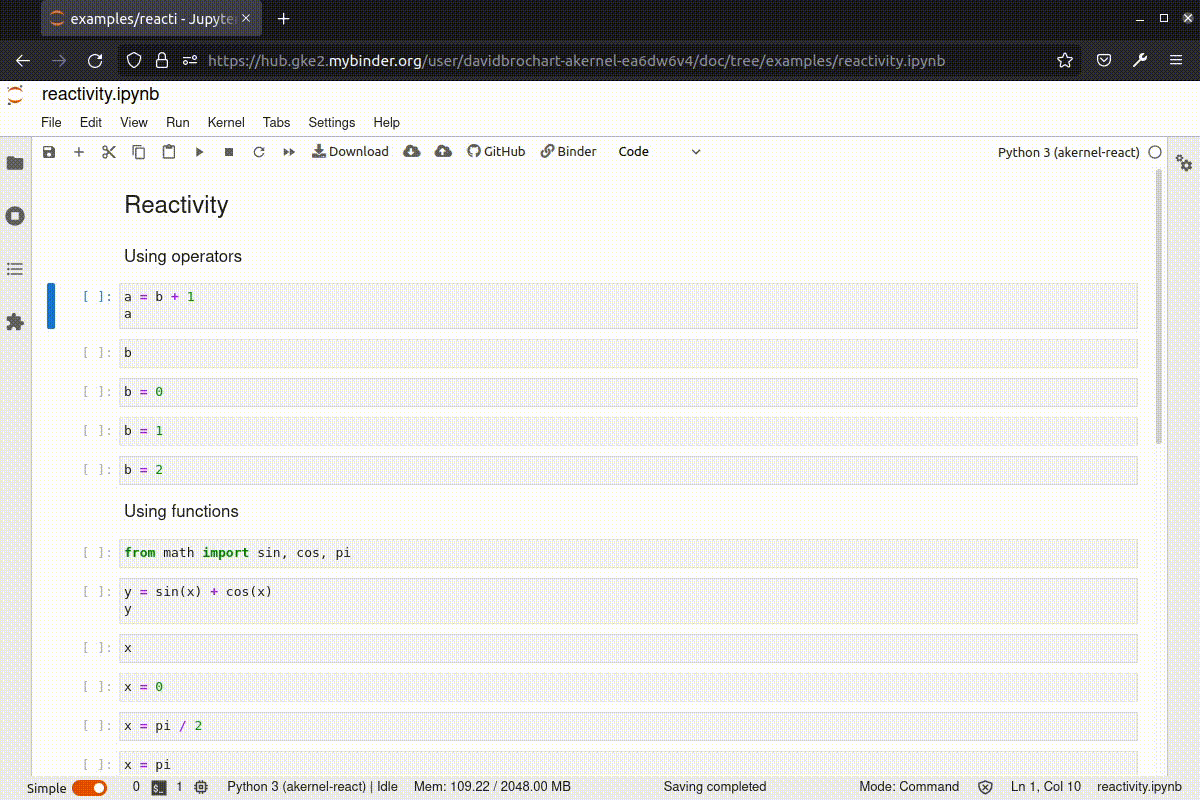An asynchronous Python Jupyter kernel
Project description
akernel
A Python Jupyter kernel, with different flavors:
- concurrent cell execution,
- reactive programming,
- cell execution caching,
- multi-kernel emulation.
Install
pip install akernel
# pip install akernel[react] # if you want to be able to use reactive programming
# pip install akernel[cache] # if you want to be able to use cell execution caching
You can parameterize akernel's execution mode:
akernel install # default (chained cell execution mode)
akernel install concurrent # concurrent cell execution mode
akernel install react # reactive programming mode
akernel install cache # cell execution caching mode
akernel install multi # multi-kernel emulation mode
akernel install cache-multi-react-concurrent # you can combine several modes
Motivation
ipykernel offers the ability to
run asynchronous code from the REPL.
This means you can await at the top-level, outside of an async function. Unfortunately, this will still
block the kernel.
akernel changes this behavior by launching each cell in a task. By default, cell tasks are chained, which means that a cell will start executing after the previous one is done. You might wonder, is it not the same as ipykernel then? Well, not quite. In ipykernel, when an async cell is executing, it also blocks the processing of Comm messages, which prevents the kernel from interacting with e.g. JupyterLab widgets (see here and there). In akernel, it will not be the case.
If you want to go all the way and have cells execute concurrently, you can also do so (see below).
Features
Asynchronous execution
First, set the concurrent execution mode in order to have async cells execute concurrently
(you could also do that at install-time with akernel install concurrent):
__unchain_execution__()
# __chain_execution__()
akernel allows for asynchronous code execution. What this means is that when used in a Jupyter notebook, you can run cells concurrently if the code is cooperative. For instance, you can run a cell with the following code:
# cell 1
for i in range(10):
print("cell 1:", i)
await asyncio.sleep(1)
Since this cell is async (it has an await), it will not block the execution of other cells.
So you can run another cell concurrently, provided that this cell is also cooperative:
# cell 2
for j in range(10):
print("cell 2:", j)
await asyncio.sleep(1)
If cell 2 was blocking, cell 1 would pause until cell 2 was finished. You can see that by changing
await asyncio.sleep(1) into time.sleep(1) in cell 2.
You can make a cell wait for the previous one to be finished with:
# cell 3
await __task__() # wait for cell 2 to be finished
print("cell 2 has run")
Reactive programming
One feature other notebooks offer is the ability to have variables react to other variables' changes. Observable notebooks are a good example of this, and it can give a whole new user experience. For instance, you can run cells out of order:
# cell 1
a = b + 1 # "b" is not defined yet
a
Executing cell 1 won't result in an "undefined variable" error. Instead, the result of the
operation is undefined, and the output of cell 1 is None. You can then continue with the
definition of b:
# cell 2
b = 2 # triggers the computation of "a" in cell 1
Now a, which depends on b, is automatically updated, and the output of cell 1 is 3.
You can of course define much more complex data flows, by defining variables on top of other ones.
Cell execution caching
With this mode, cell execution is cached so that the next time a cell is run, its outputs are retrieved from cache (if its inputs didn't change). Inputs and outputs are inferred from the cell code.
Multi-kernel emulation mode
This mode emulates multiple kernels inside the same kernel. Kernel isolation is achieved by using the session ID of execution requests. You can thus connect multiple notebooks to the same kernel, and they won't share execution state.
This is particularly useful if cells are async, because they won't block the kernel. The same kernel can thus be "shared" and used by potentially a lot of notebooks, greatly reducing resource usage.
Limitations
It is still a work in progress, in particular:
stdout/stderrredirection to the cell output is only supported through theprintfunction.- No rich representation for now, only the standard
__repr__is supported. This means no matplotlib figure yet :-( But since ipywidgets work, why not using ipympl? :-)
Project details
Release history Release notifications | RSS feed
Download files
Download the file for your platform. If you're not sure which to choose, learn more about installing packages.















